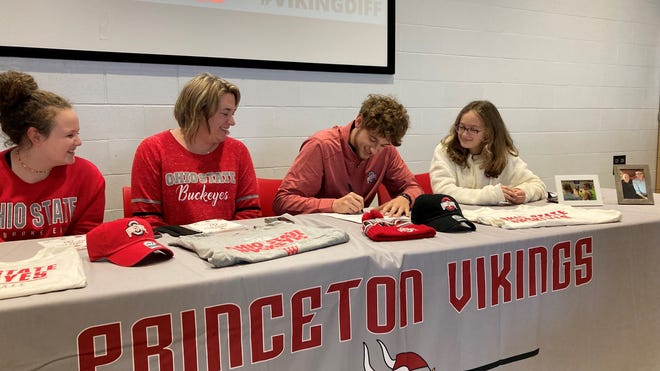Six days before opening fire in a Colorado grocery store and killing 10 people, a 21-year-old suspect in the massacre bought a Ruger AR-556 pistol - a weapon with a controversial history in the national debate over gun regulation.
The Ruger looks like a rifle, operates like one, and even takes the same ammunition as the infamous AR-15 that has been used in many U.S. mass killings. But the Ruger is not a rifle - at least, not under current gun laws.
Billed as Ruger's alternative to the AR-15 rifle, the pistol is smaller and more maneuverable than a rifle. It also isn't bound by the strict regulations that a rifle of its size would, an issue that's cast light on the nation's gun laws and led to calls for change.
"If you cut off the back end of the AR-15 and you shorten up the muzzle – the front part where the bullet comes out – it’s the same thing," said Christopher Herrmann, a former New York City police officer and an assistant professor at John Jay College of Criminal Justice. "You’ve taken this deadly AR-15 weapon and now you’ve made it concealable."
Like the AR-15, the gun is semiautomatic. It's a portable "weapon of mass destruction," Herrmann said — "all the comforts of a limousine but in a smaller car."
For the Colorado shooting suspect, the Ruger AR-556 pistol had another benefit: It made purchasing the weapon quick and easy. A rifle of its same size would have been subject to multiple layers of added scrutiny, including a background check that would have required several forms of ID and even fingerprinting. The suspect would have had to pay additional taxes and potentially wait months before the gun was registered.
But the Colorado suspect didn't have to wade through the added red tape for the Ruger, since it is a pistol.
Police in Boulder have not specified what guns were used in the attack. In a charging affidavit, authorities noted the suspect was found with two weapons, one that they repeatedly called a rifle, and state he had purchased the Ruger AR-556 pistol days before the attack. A spokeswoman for the Boulder Police Department would not clarify Thursday what weapons the suspect carried with him during the attack.
A look at the Ruger AR-556 pistol
A new Ruger AR-556 pistol can range in price from about $900 to $950. New AR-15 rifles range in price from around $500 to several thousand dollars.
Typically, the Ruger AR-556 pistols have a capacity of 30 rounds, similar to that of rifles. This offers the potential to carry more bullets in the chamber than most glocks or smaller pistols that typically can carry about 10 to 15 bullets, though Colorado law doesn't allow magazines with more than 15 rounds.
The pistols don't use 9mm rounds, typically found in most smaller pistols, and instead are outfitted to use the same high-velocity ammunition used in AR-15 styled rifles, which were originally designed for military use.
The pistols mirror an AR-15 in most ways but has a shorter barrel, models range from 9.5 to 10.5 inches in length, and is made to be operated with one hand. To compare, Ruger's AR-556 rifle has a barrel about a half-foot longer at 16.1 inches.
The pistols come with an adjustable stabilizing brace, an accessory that straps around one's arm to help fire a weapon one-handed. Ruger says the brace helps "to aid in accuracy, balance and recoil management."
The brace essentially replaces a buttstock, which sits at the end of most long guns, like rifles, to help absorb recoil.
Why is the Ruger AR-556 a pistol and not a rifle? Does it matter?
Firearms are defined and categorized at the federal level under the Gun Control Act, which was passed in 1968. The Bureau of Alcohol, Tobacco, Firearms and Explosives, which helps regulate weaponry, details how different weapons are categorized and the the steps that need to be taken in order to purchase one.
The Gun Control Act defines a pistol as a weapon intended to fire a bullet with a short stock that is "designed to be gripped by one hand." The photos that accompany the definition on the ATF's website show a common depiction of a pistol, not the longer-barreled weapon bought by the Boulder shooting suspect.
The definition doesn't note anything about the length of a barrel, meaning longer pistols like the Ruger AR-556 that mirror a rifle can still be categorized as a pistol if it meets the criteria, said Rick Vasquez, a former ATF firearms enforcement officer who owns a firearms business that offers training in identifying firearms and on regulations.
A rifle is defined under the Act as a weapon intended "to be fired from the shoulder" and to fire a single bullet for each pull of the trigger.
More:Gun groups' success blocking local firearm controls leaves towns desperate to stop massacres
More:Why the AR-15 keeps appearing at America's deadliest mass shootings
"If I can hold it in one hand and I can fire it in one hand and it's designed that way, it's only a handgun," he said. He added these AR-styled pistols have become a favorite of gun buyers.
"The pistol version has gotten extremely, extremely popular because it's small, it's a pistol that fires a rifle-caliber cartridge, which gives it a lot of strength over a regular pistol cartridge, and it's very maneuverable," Vasquez said.
Vasquez noted the gun's compact nature is a feature that helps both conceal it and makes it more maneuverable. But in some ways, the weapon mirrors a short-barrel rifle, which are heavily regulated under the National Firearms Act due to those exact factors. A short-barrel rifle is defined in the Act as a rifle with a barrel shorter than 16 inches. The Ruger AR-556 pistol has a barrel of anywhere from 9.5 to 10 inches.
The Act regulates certain weapons and attachments, including machine guns, silencers and sawed-off shotguns. It poses stringent rules and a lengthy process in order to purchase these weapons. Among the provisions, a person must be approved by the ATF, pass an extensive background check, submit photos and fingerprints, fully register the gun and pay a tax.
Vasquez said the process typically takes months. The suspect in the Boulder shooting purchased the Ruger AR-556 six days before the attack.
Growing concerns about AR pistols
Academics and law enforcement officers have long been concerned about the proliferation of AR-style pistols, which have existed for more than a decade, said Garen Wintemute, an emergency physician and director of the Violence Prevention Research Program at the University of California, Davis who is a member of the National Rifle Association.
"The concern is that these weapons represent a very substantial increase in firearm power and lethality over conventional handguns, on balance. There’s a potential that they will be manufactured in large numbers by people with criminal intent, at home," he said.
"Whether it’s for violent extremists, political violence or crime of other sorts, it’s been a concern for a long time. And I think a lot of us who have had that concern have been surprised that they’re not more prominent than they are. That may change unless we nip it in the bud."
The city of Boulder passed a measure in 2018 that aimed to eliminate assault-styled weapons. It was overturned in court 10 days before the shooting at King Soopers. Authorities have yet to say where the suspect purchased the Ruger pistol. Even if bought in Boulder, it's unclear whether it would have definitively been covered by the town’s former ban, which included many semi-automatic rifles and pistols.
Herrmann, the former New York City police officer, said he’s concerned that the guns are sold off the shelf. "There’s definitely no purpose for it except killing. That’s what it was designed for," he said.
Wintemute said he’s even more concerned that the style of gun could be easily manufactured as a ghost gun – firearms not made in regulated manufacturing facilities without serial numbers or paper trails.
"It’s easy to make a ghost gun AR rifle, and I don’t know of any reason why it would not be easy to home manufacture a ghost gun AR pistol," he said. "The time to intervene to prevent these developments from occurring is right now."
In the wake of the Boulder shooting, as well as the Atlanta-area shootings less than a week before, President Joe Biden spoke forcefully about passing gun reform legislation, saying that "we have to act" to pass gun background checks and ban assault weapons.
But in his first press conference as president Thursday, Biden was asked only once about the topic of gun control. When asked whether he will send legislation to Congress, sign executive orders, or send money to cities and states to address gun control, Biden answered: "All of the above." He then quickly pivoted to talking about infrastructure legislation he plans to unveil next week.
Source link










